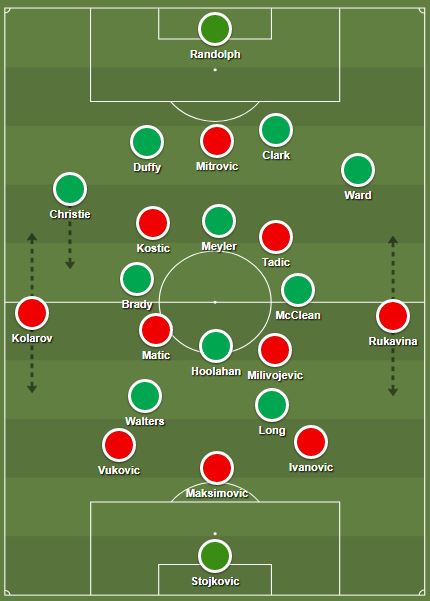Alan O’Brien Follow @alanob2112
With Wesley Hoolahan at its tip, the midfield diamond has been integral to most of the Republic of Ireland’s best football under Martin O’Neill. But a make-or-break qualifier, against a Serbian 3-4-2-1, was, unequivocally, not the time to revive it.

Reintegrating the Norwich City man meant a return to the 4-3-1-2 formation last seen in the opening half-hour of Hoolahan’s last start — away to Austria.
Designed to give the cotton-woolled 35-year-old a free role, with three central-midfielders to do his dirty work, the system was central to famous home victories over Germany and Bosnia.
Diamond blights
Since Saturday’s haphazard showing away to Georgia, from which a planless Irish side limped away with a point, murmurs have rightly grown over the manager’s apparent ad-hoc approach to his job.
From the old-school of football management, a proper-football-man, O’Neill could not possibly be expected to realise how ill-equipped a diamond is to combat a 3-4-2-1.
Serbian coach Slavojub Muslin must have been delighted. His settled side boasted a spare-man in central-defence, two defensive-midfielders to handle Ireland’s only creative outlet, and free-reign for its wing-backs. How bad.
Eamonn Dunphy’s half-time love-in, focused on Hoolahan’s first-half showing, was baffling, as the little number-10 had found himself crowded-out throughout. Vainly drifting wide to find space, with either Nemanja Matic or Luka Milivojevic in tow, Hoolahan was a complete creative non-factor.
Mixed fortunes out wide
With four central midfielders apiece cancelling each other out, the space was indeed available out wide, however. The shared reluctance of both Serb number-10s, Filip Kostic and Dusan Tadic, to track back offered Ireland an opportunity.
But, the identities of Ireland’s full-backs saw that opportunity wasted. The only free men in green jerseys — Stephen Ward and, particularly, Cyrus Christie — spurned several promising attacking-third moments with dreadful final-balls.
Serbia’s wing-backs were free too, as they were in Belgrade last September. Jonathan Walters and James McClean failed to track Antonio Rukavina and first-competitive-cap Filip Mladenovic throughout that 2-2 draw. Indeed, it was Mladenovic’s continual freedom that led directly to Tadic’s penalty-kick.
Here, while Ireland’s shuttlers, McClean and Robbie Brady, pressed Rukovina and Aleksander Kolarov fairly well, switches-of-play posed an unsolvable problem.
Rukovina, free at the back-post, should have converted a Filip Kostic cross before half-time. Eventually, his fellow-flanker Kolarov did the damage, overcoming a desperate Walters recovery run to finish a quick Tadic/Kostic switch.
Hello Mr. Thompson
With Hoolahan nullified, and their full-backs offering little, Ireland were in desperate need of that lesser-spotted player in modern-day football — the winger.
Invading the space behind advanced wing-backs, pulling the outside centre-backs out of position, is the way to go against a system sporting a back-three. Any layman can tell you that.
And yet, even after two substitutions, and Nikola Maksimovic’s dismissal, O’Neill kept the faith with his narrow, ineffectual, diamond. If it was inappropriate to trouble a back-three, it was damn sure inappropriate against the visitors’ necessarily-narrow ten-man cohort.
As if to drill the point home to his manager, Bristol City’s Callum O’Dowda, introduced on the left of O’Neill’s diamond, created Ireland’s only real chance to that point. O’Dowda’s 76th-minute sortie down the left-flank, to the byline, produced a back-post cross that Christie skied. O’Neill, predictably, did not get the message.
Route-one
Instead, the former Leicester City boss relied on brute force to get him out of jail, as it had done away to Serbia, and at home to Austria.
Route-one to substitute Daryl Murphy won the corner that saw Ireland equalise in Belgrade, and it was the Nottingham Forest man — plus two other target men, and a late, late Shane Duffy promotion — that O’Neill banked on to save him again.
Credit where it’s due: route-one to Long did draw Maksimovic’s fatal foul on Murphy, and created Ireland’s best chance of the game, when Murphy was foiled by Vladimir Stojkovic. Murphy should have had a penalty too, fouled while the aforementioned O’Dowda centre hung in the air. Cuneyt Cakir strikes again.
Serbia were temporarily down to nine men at that point, thanks to a Jagos Vukovic injury, and that’s the way they more-or-less stayed for the game’s remainder, as a crocked Vukovic was forced to just stay up top. O’Neill still did not get the message. Keep on route-oneing on, was his clarion-call.
Conclusion
It didn’t come off this time, and a previously-blessed O’Neill’s luck finally ran out. He was embarrassed here by the well-traveled Muslin, whose timely introduction of Stefan Mitrovic wisely preserved Serbia’s spare-centre-back after the red-card.
Conor Hourihane’s arrival, for the excellent David Meyler, was also met with an additional Serb midfielder, in Nemanja Gudelj. If only Ireland had a manager with such basic tactical intelligence at their disposal. Time to go, Martin.
Follow the author, Alan O’Brien, on Twitter: Follow @alanob2112